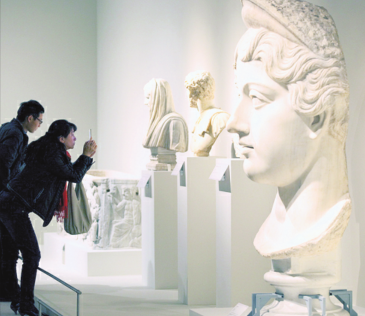
JIANG DONG/CHINA DAILY
Visitors are attracted by the exhibition Mediterranean Civilization in the National Museum of China.
After two centuries standing at the Louvre, Diana de Gabies leaves France for the first time and greets viewers at a Chinese museum, as a warm-up to celebrate the establishment of diplomatic relations between the two countries five decades ago.
The Roman-era marble statue, also called The Sculpture of Artemis, portrays a gracefully standing Artemis, aka the Goddess of the Hunt, who is ready to buckle her cloak that is presented by her believers.
Dated back to about the first century, the statue is testimony to the Roman copy of Greek style. It was excavated in 1792 by the British history painter Gavin Hamilton (1723-98) at Gabii, Italy, and was later purchased by Napoleon, who then gave it to his brother-in-law Prince Camillo Borghese as a gift.
Artemis is placed right before Hamilton's oil painting which was drawn from the Greek mythology—Venus introduces Helen to Paris, a dangerous prelude to the Trojan War—and became part of the Louvre collection in 2011.
Together, they are sharing the stage at the National Museum of China with about 280 pieces and sets of antiquities from the Louvre's treasure trove to form the exhibition Mediterranean Civilization.
The exhibition marks the first cooperation between the Louvre and the National Museum of China. Meanwhile, according to Jean-Luc Martinez, president-director of the Musee du Louvre, it provides a chance to inspect the Louvre's collections from a different perspective.
"One of our duties at the Louvre is not only to showcase French art but also the world's diverse cultures," Martinez says.
"For example, the French royal collections (a major source of the Louvre's displays) boast Italian paintings and Greek and Roman sculptures. The most famous works at the Louvre come from the Mediterranean, a cradle of human civilization, and that's why we have come up with the theme of this exhibition."
The Louvre's three iconic collections, Venus de Milo, Mona Lisa and The Winged Victory of Samothrace, all celebrate the Mediterranean civilization over a time span of four millenniums.
At the exhibition, works from eight curatorial departments at the Louvre including sculptures, potteries, gold and silver wares and paintings, are assembled for the first time to exemplify the communications and clashes among different cultures nurtured by the Mediterranean Sea.
Works also making a debut appearance in China include an extravagant pocket watch once belonging to Charles X of France. The product of the queen of England's watchmaker is ornamented with 265 diamonds. It came into the French king's collection as a gift from the Dey of Algiers between about 1815 and 1816, demonstrating France's powerful presence in the Mediterranean along with the Ottoman Empire's decline in the 19th century.
The exhibition adds the Louvre to NMC's top-of-the-line partners since its reopening in 2011, which include the Met, the Uffizi Gallery and the British Museum. NMC's deputy director Huang Zhenchun says that exhibiting with these world-class museums has compensated for an inadequate collection of Western art at the NMC.
One of the most visited museums, the Louvre received 9.75 million visitors in 2012, of which foreigners accounted for 70 percent, Martinez says. Chinese visitors, numbering 440,000, formed the second largest foreign group after the Americans.
"The museum has seen a 40-percent increase of Chinese viewers annually, and China is likely to be the top source of visitors to the Louvre in years to come," the director says.
The age-old art museum has been bold in embracing a modern connection and extending its influence. It launched a Nintendo 3-DS (a portable game console) audio guide in 2012.
Its regional branch, the Louvre-Lens in Northern France, received 800,000 visitors in the first 10 months of its opening in December 2012; and the Louvre Abu Dhabi is scheduled to open in 2015, viewed as "an overseas sample to bring French culture to the world scene", Martinez says.
Taking the current position in April 2013, Martinez has planned several educational projects to reach out to those who seldom visit museums: re-writing the introduction boards of all exhibition halls to make antiquities more accessible to viewers, and establishing one exhibition hall about the art history and another one introducing the Louvre's past as a royal relic site.
"The Louvre will take quite a different look in 2014," the director says.
IF YOU GO
9 am-5 pm, closed on Monday and Jan 31 (the Lunar New Year), until Feb 9. National Museum of China, east of Tian'anmen Square, 16 East Chang'an Jie (Avenue), Dongcheng district, Beijing. 010-6511-6400.
We recommend:
